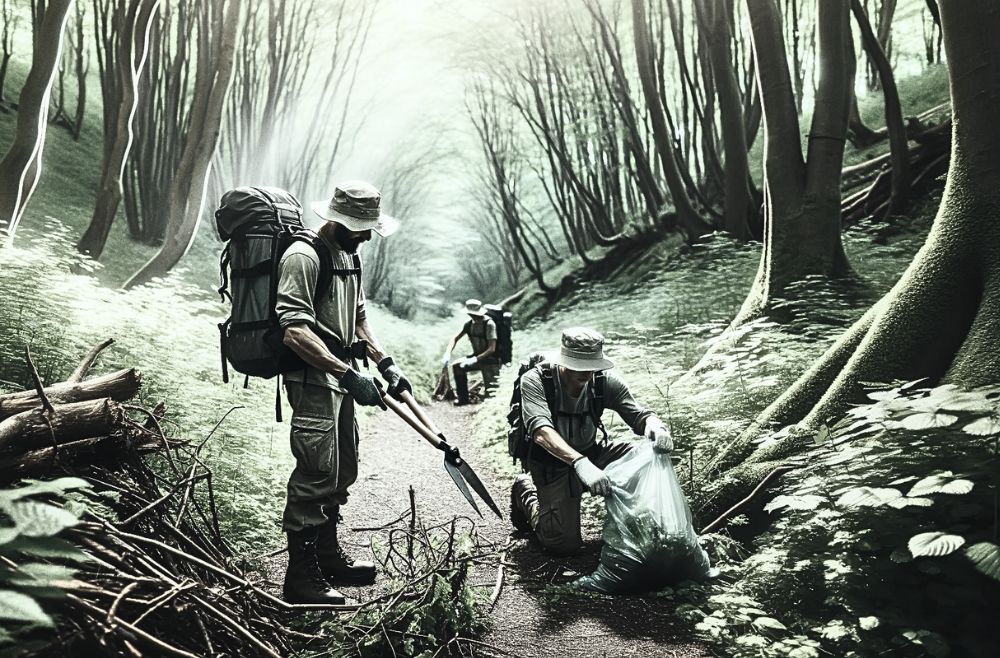Are you ready to hit the trail and learn the ropes of sustainable trail maintenance? When it comes to preserving nature, knowledge is power.
As a hiker, you have the power to make a difference and keep trails safe and enjoyable for all. This guide will equip you with the tools you need to make your next hike a success, from understanding the basics of trail maintenance to volunteering for projects that make a lasting impact.
So, let’s get started: buckle up and get ready to explore the world of sustainable trail maintenance!
Key Takeaways
- Take responsibility for actions and clean up garbage
- Avoid creating shortcuts to prevent erosion
- Preserve trails for future enjoyment
- Ensure trails stay safe and sustainable
In This Article
Understanding Trail Maintenance
Understanding trail maintenance is key to making sure trails stay safe and sustainable. To do so, hikers must take responsibility for their actions and clean up after themselves, such as by picking up any garbage they come across.
Additionally, they should avoid creating shortcuts, as this can cause additional erosion. Taking these steps will help keep trails in good condition, so that everyone can enjoy them for years to come.
When hiking, be conscious of your actions and think about how they might affect the trail. Doing your part to reduce erosion and clean up garbage will keep trails in great shape and give others the freedom to explore.
Preparing to Maintain Trails
Before taking on a trail maintenance project, it’s important to plan and prepare. To ensure success, be sure to:
- Properly equip yourself with the right supplies and tools.
- Assess the current conditions of the trail.
- Research local regulations and restrictions.
- Have a clear vision of the end result.
- Remain patient and organized throughout the process.
Having the proper supplies, knowing the local regulations, and understanding the conditions of the trails will help you determine the best course of action for your project. Be sure to take the time to properly equip yourself and assess the conditions before beginning a trail maintenance project.
With the right preparation, you can take the steps necessary to protect and preserve the trails for future hikers to enjoy.
Sustainable Trail Maintenance Practices
| Maintaining trails sustainably is key to preserving their integrity and allowing future users to enjoy them. | Respect Nature | Minimize Impact |
|---|---|---|
| Stay on trail | Don’t cut switchbacks | Pack out trash |
| Don’t create shortcuts | Don’t litter | Keep pets leashed |
Knowledgeable hikers understand the importance of respecting nature and minimizing impact while on the trail. When hiking, it is important to stay on the designated trail, not cut switchbacks, and not create new shortcuts.
Picking up trash, as well as not littering, is also important to keep the trails clean. Pet owners should also be sure to keep their pets leashed to prevent any disruption of the natural environment.
By following these simple guidelines, hikers can ensure that trails remain in their best condition for future visitors.
Responsible Use of Trails
When using trails, it’s important to be responsible and mindful of your actions. Here are a few ways to ensure you’re minimizing your impact and respecting wildlife:
-
Stay on the trails – that means no shortcuts!
-
Leave no trace – this means take all your garbage with you and avoid disturbing natural habitats.
-
Respect wildlife – keep your distance and don’t feed them.
-
Keep noise to a minimum – loud noises can scare away wildlife.
-
Leave the trail better than you found it – if you can, take a few moments to pick up trash or fix up any damage.
Volunteering for Trail Maintenance Projects
You can help keep trails in top condition by volunteering for trail maintenance projects! To find volunteers, reach out to local and regional outdoor organizations, or get the word out online.
Once you have volunteers, it’s important to assess the trail’s impact before beginning any projects. Divide the trail into sections and assign volunteers to each one. Assess the trail’s needs and prioritize tasks, such as:
| Task | Estimated Time | Difficulty |
|---|---|---|
| Clearing debris and overgrowth | 45 minutes | Moderate |
| Removing rocks and roots | 1 hour | Difficult |
| Repairing tread | 2-3 hours | Hard |
| Re-establishing water bars | 1-2 hours | Moderate |
| Replacing signage | 45 minutes | Easy |
What’s Next?
You have the power to make a real difference and leave a lasting impact on the trails you love. By taking the time to practice sustainable trail maintenance now, you’ll be protecting and preserving the trails for future generations of hikers.
With the right knowledge and preparation, you can ‘cut the ribbon’ on a cleaner, greener trail that will stand the test of time.
Together, we can ensure that our trails will remain beautiful and accessible for years to come.
Survival MD

Exclusive Report Reveals The Most Comprehensive Guide To Survival Medicine
- What to do when there is no doctor available
- How to make it without electricity
- Reattach a tooth using salt water
- How to improvise a splint from a plank, pillow, or rolled-up newspaper
- Safely dress a burn in food wrap or a plastic bag
- Powerful proven-to-work home remedies
- Water filtration basics
- How to make your own antiseptic and sanitizer
- And much more…



We are participants in the Amazon Services LLC Associates Program, an affiliate advertising program designed to provide a means for sites to earn advertising fees by advertising and linking to Amazon.com